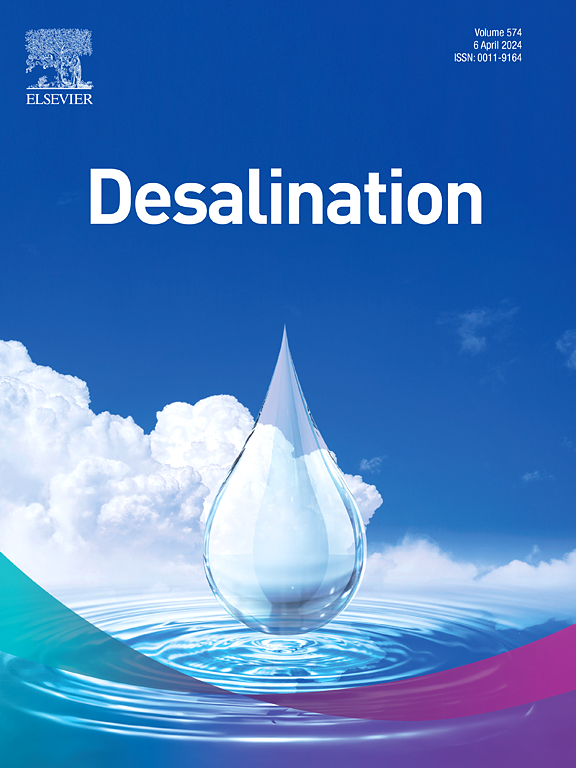Dual-functional GO composite aerogels for water purification and desalination via heavy metal adsorption and solar evaporation
IF 8.3
1区 工程技术
Q1 ENGINEERING, CHEMICAL
引用次数: 0
Abstract
Freshwater scarcity and heavy metal (HM) contamination are significant global challenges. Herein, a graphene oxide/tannic acid/polyethyleneimine mixed aerogel was developed (GTPA) with dual functions of efficient adsorption of HM and solar-powered desalination. The adsorption of Cr(VI) and Pb(II) follows Langmuir isotherms and pseudo-second-order kinetics, indicating monolayer chemisorption. Thermodynamic experiments confirmed that adsorption can occur spontaneously. The maximum adsorption capacities of Cr(VI) and Pb(II) by GTPA were 434.78 mg·g−1 and 304.88 mg·g−1, respectively, and the equilibrium time was 90 min, and it showed excellent adsorption performance in coexisting ions and natural wastewater solutions. Experimental and DFT analyses showed that the adsorption mechanism mainly involved hydrogen bonding, chelation, electrostatic interactions, and synergistic effects. After 5 cycles, the adsorption efficiencies of Cr(VI) and Pb(II) by GTPA were 78.21 % and 73.18 % respectively. In solar desalination applications, the abundant hydrophilic groups in GTPA effectively break the hydrogen bond between water molecules and reduce the enthalpy of evaporation; Its high porosity and hierarchical pore structure extends the light path through multiple reflections and scattering, which improves the photon absorption efficiency. Under one-sun irradiation, GTPA achieved a water evaporation rate of 2.38·kg m−2·h−1 and a photothermal conversion efficiency of 88.23 %. The porous structure and high adsorption capacity effectively inhibit salt crystallization and promote rapid water transport, maintaining efficient desalination even under high salt concentration conditions. The evaporated seawater was found to meet WHO and EPA standards for drinking water. GTPA effectively prevented impurities such as metal ions from entering the condensate by adsorbing contaminants. The results demonstrate that GTPA offers a novel strategy for designing aerogels with enhanced adsorption capacity and superior photothermal desalination performance.
双功能氧化石墨烯复合气凝胶通过重金属吸附和太阳能蒸发净化和淡化水
淡水短缺和重金属污染是全球面临的重大挑战。本文研制了一种具有高效吸附HM和太阳能脱盐双重功能的氧化石墨烯/单宁酸/聚乙烯亚胺混合气凝胶(GTPA)。Cr(VI)和Pb(II)的吸附遵循Langmuir等温线和拟二级动力学,表明其为单层化学吸附。热力学实验证实吸附可以自发发生。GTPA对Cr(VI)和Pb(II)的最大吸附量分别为434.78 mg·g−1和304.88 mg·g−1,平衡时间为90 min,在共存离子和天然废水溶液中均表现出优异的吸附性能。实验和DFT分析表明,吸附机理主要包括氢键、螯合、静电相互作用和协同作用。循环5次后,GTPA对Cr(VI)和Pb(II)的吸附效率分别为78.21%和73.18%。在太阳能脱盐应用中,GTPA中丰富的亲水性基团有效地破坏了水分子间的氢键,降低了蒸发焓;它的高孔隙率和分层孔隙结构通过多次反射和散射延长了光路,提高了光子吸收效率。在单太阳照射下,GTPA的水分蒸发速率为2.38·kg m−2·h−1,光热转换效率为88.23%。多孔结构和高吸附能力有效抑制盐结晶,促进水分快速输送,即使在高盐浓度条件下也能保持高效脱盐。蒸发的海水符合世界卫生组织和美国环保署的饮用水标准。GTPA通过吸附污染物,有效阻止金属离子等杂质进入凝结水。结果表明,GTPA为设计具有增强吸附能力和优越光热脱盐性能的气凝胶提供了一种新的策略。
本文章由计算机程序翻译,如有差异,请以英文原文为准。
求助全文
约1分钟内获得全文
求助全文
来源期刊

Desalination
工程技术-工程:化工
CiteScore
14.60
自引率
20.20%
发文量
619
审稿时长
41 days
期刊介绍:
Desalination is a scholarly journal that focuses on the field of desalination materials, processes, and associated technologies. It encompasses a wide range of disciplines and aims to publish exceptional papers in this area.
The journal invites submissions that explicitly revolve around water desalting and its applications to various sources such as seawater, groundwater, and wastewater. It particularly encourages research on diverse desalination methods including thermal, membrane, sorption, and hybrid processes.
By providing a platform for innovative studies, Desalination aims to advance the understanding and development of desalination technologies, promoting sustainable solutions for water scarcity challenges.
 求助内容:
求助内容: 应助结果提醒方式:
应助结果提醒方式:


